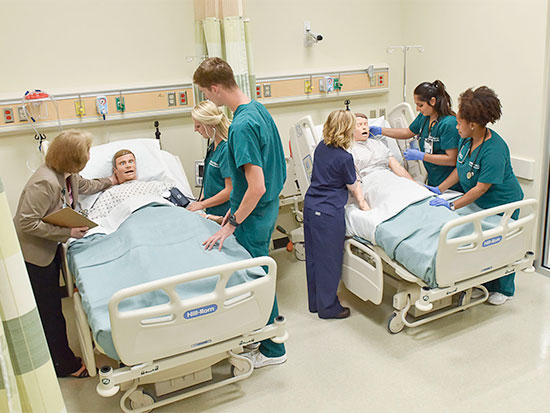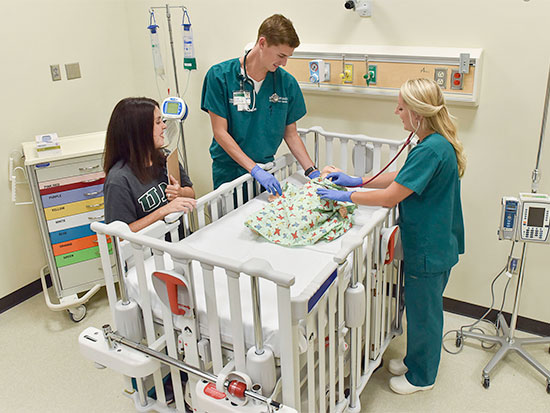 UAB School of Nursing BSN students in the newly constructed simulation competency suites with instructors running simulations.
UAB School of Nursing BSN students in the newly constructed simulation competency suites with instructors running simulations.
A building does not make a school, but it does help faculty educate and guide the students inside it. It also enables researchers to develop the latest health care advances and clinicians to deliver health care of the highest quality.
With the latest technology-enhanced classrooms and nursing competency labs — including an actual operating room and lifelike manikins — the expanded and renovated School of Nursing building at the University of Alabama at Birmingham will help the school further elevate its leadership role in educating students, and developing nurse faculty and nurse scientists to continue to drive the future of nursing and health care in Alabama and around the world.
“Our expanded and renovated building is organized around innovative teaching, research and collaborative spaces designed to advance the missions of the UAB School of Nursing,” said Doreen C. Harper, Ph.D., UAB School of Nursing Dean and Fay B. Ireland Endowed Chair in Nursing. “This state-of-the-art building will enable our faculty to prepare the next generation of compassionate and highly competent nurses to deliver expert and innovative care, conduct research that will lead to new standards of care, and generate better health care solutions for all population groups throughout our city, state and world.”
The grand opening of the $32 million, 72,000-square-foot expansion and renovation will take place Thursday, Sept. 6, at 5:30 p.m. at 1701 University Blvd. Students began classes in the building Monday, Aug. 27.
“Our School of Nursing is integral to UAB’s growth and success in all areas of our mission, and we are proud of our national and global leadership in nursing,” said UAB President Ray L. Watts. “We are among the top 15 schools of nursing nationally in NIH funding and were recently named a Center of Excellence for Nursing Education by the National League for Nursing. The future is even brighter with this expansion and renovation, a key part of UAB’s Campus Master Plan, as it provides some of the most technologically advanced learning spaces in the nation to continue training the highly skilled, innovative and compassionate nurse-leaders of tomorrow.”
The technology inside the facility will usher in a new era in nursing education, research and clinical practice, harnessing the latest innovations and technological advances to engage students, promote active learning and teamwork, and encourage research and practice collaboration.
For example, each classroom, including The Leadership Institute and Rick M. and Barrett Brock MacKay Nightingale Scholars Gallery, is equipped with device-sharing technology, smartboards and short throw projectors that allow students to share what they see on their screens with the class and their instructors. Teams of clinicians and researchers can also work on the projectors to translate the latest discoveries to the bedside. A special classroom, the Innovation Collaboratory, has interactive workstations for sharing ideas and information among a team or with the entire room. It also has streaming capabilities, for sharing real-time video on campus and around the world.
 Nursing students gain hands-on experience in the pediatric and hospital competency labs. “We are able to interact with students and make what we are teaching a collaborative learning experience instead of the ‘sage on the stage,’ where the faculty member is the only one who has knowledge. Learning becomes a joint process and is no longer a top-down model,” said Jacqueline Moss, Ph.D., associate dean for Technology and Innovation in the School of Nursing. “But this room is not limited to teaching students. Teams of nurses can collaborate with each other or health care colleagues in the room or, in reality, anywhere there is the ability to connect, to collaborate on innovative bedside health care solutions or with health care, business and policy professionals to develop solutions for high-quality, affordable health care for all populations.”
Nursing students gain hands-on experience in the pediatric and hospital competency labs. “We are able to interact with students and make what we are teaching a collaborative learning experience instead of the ‘sage on the stage,’ where the faculty member is the only one who has knowledge. Learning becomes a joint process and is no longer a top-down model,” said Jacqueline Moss, Ph.D., associate dean for Technology and Innovation in the School of Nursing. “But this room is not limited to teaching students. Teams of nurses can collaborate with each other or health care colleagues in the room or, in reality, anywhere there is the ability to connect, to collaborate on innovative bedside health care solutions or with health care, business and policy professionals to develop solutions for high-quality, affordable health care for all populations.”
The school is well-known for producing professional and advanced practice nurses to care for patients with increasing rates of chronic disease, especially those in rural and underserved areas.
Faculty have been using innovative virtual educational experiences to provide nursing education and professional development, and to reach rural patients through telehealth research and clinical activities. The technologies in these classrooms and throughout the expansion and renovation will enhance and grow this reach.
“We have made great strides in impacting health care in Alabama through our education programs, clinical practices and innovative research, and are leading the field in providing more health care access to the medically underserved in rural and urban Alabama,” Harper said. “With the additional technology in the building, that impact is only going to grow.”
The School of Nursing building will also give students and health care professionals hands-on learning experiences with the new nursing competency labs. The facility has five new labs for nursing simulations, which includes a working operating room and nurses station, and also has the Alacare Home Health and Hospice Nursing Skills Suite given in honor of Susan B. Brouillette, chief executive officer of Alacare. Each lab has the same equipment as a hospital room or home and comes with a manikin that simulates real-life scenarios.
The manikins can connect to a variety of monitors, providing real-time information such as heart rate, oxygen levels and blood pressure readings. Instructors will control the manikin’s symptoms and observe the students from rooms connected to each lab.
| "The new nursing competency labs let students choose among possible solutions to a problem and practice their skills all the way through. These labs also give us the ability to offer professional development opportunities that are second to none for nurses and our other health care colleagues.” |
“Students will now be able to operate on, treat and experience real-life scenarios with faculty serving as coaches,” said Penni Watts, Ph.D., director of Clinical Simulation in the School of Nursing. “They get to practice decision-making through simulating the full continuum of patient care. The new nursing competency labs let students choose among possible solutions to a problem and practice their skills all the way through. These labs also give us the ability to offer professional development opportunities that are second to none for nurses and our other health care colleagues.”
Harper says, with this project, the school is afforded the opportunity to do things that have never been done before — and none of these things would be possible without the support of the school’s generous donors.
“The new classroom technologies, virtual and simulation experiences, innovative hybrid courses, and research, telehealth, and collaborative space for students and faculty will only enhance our work and learning,” Harper said. “Our donors have embraced this and have shown over and over their belief that, through our school’s, students’ and faculties’ mastery of innovation and technological competencies, together with other holistic professional nursing competencies of human caring, knowledge, judgment and practice, our school is the future of dynamic change in high-quality health care for all populations.”
William Blackstock Architects of Birmingham and Payette of Boston served as the architects on this project. M.J. Harris Construction Services LLC of Birmingham was the contractor.
